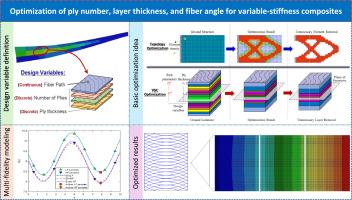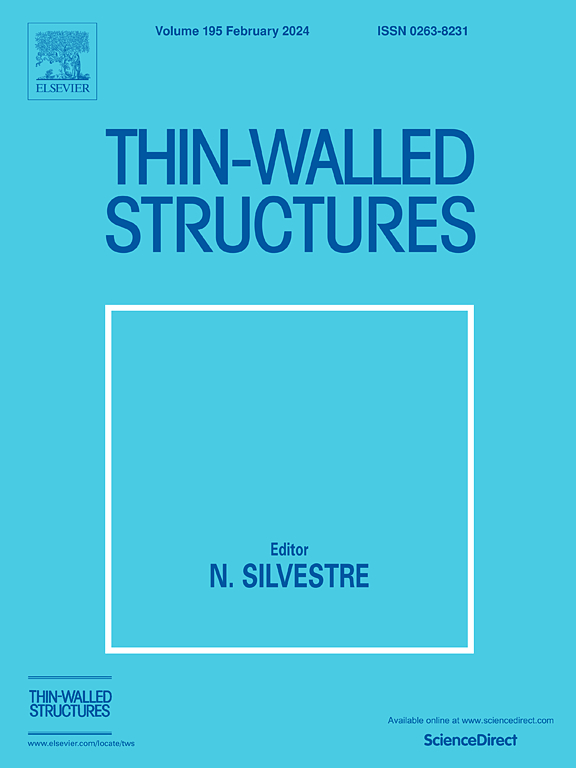利用动态多保真代理模型综合优化变刚度复合材料的层数、层厚和纤维角度
IF 5.7
1区 工程技术
Q1 ENGINEERING, CIVIL
引用次数: 0
摘要
为了充分利用具有空间变化纤维取向角的可变刚度复合材料层压板的效率,本文旨在提出一种新颖的优化框架,用于综合设计层数、层厚和纤维角度。优化问题是在定义具有冗余层的地面层压板的基础上创新提出的。基本的优化思路是在该地面层压板中寻找不必要的层和必要的层。对于不必要的层,可将其去除并分配小值层厚,而必要的层则保留在地面层压板中,并分别使用离散变量和连续变量优化确定相应的层厚和纤维角度。由于变刚度复合材料层压板总是需要高保真的分析模型来准确捕捉不同纤维的空间特征,这就导致了一个耗时的过程。为了缓解这一问题,最初提出了一种基于高斯过程回归的多保真度代用模型,该模型具有基于指数的综合修正功能,可生成一个近似问题来替代原始问题。为了解决这个带有混合设计变量的近似问题,先后采用了遗传算法和顺序二次编程法。该程序的解被动态添加到采样数据集中,以更新构建的代用模型。对复合板和太阳能机翼结构进行了数值基准问题和案例研究,证明了新提出的优化策略的有效性。本文章由计算机程序翻译,如有差异,请以英文原文为准。

Integrated optimization of ply number, layer thickness, and fiber angle for variable-stiffness composites using dynamic multi-fidelity surrogate model
To fully exploit the efficiency of variable-stiffness composite laminates with spatially varied fiber orientation angles, this paper aims at presenting a novel optimization framework for integrated design of ply number, layer thickness, and fiber angle. The optimization problem is innovatively formulated based on the definition of a ground laminate with redundant layers. The basic optimization idea is to seek both unnecessary and necessary layers in this ground laminate. For unnecessary layers, they can be removed and assigned with small-value ply thicknesses, while necessary layers are retained in the ground laminate and corresponding ply thicknesses and fiber angles are optimally determined using discrete and continuous variables, respectively. Since variable-stiffness composite laminates always require high-fidelity analysis models to accurately capture the spatial characteristics of varying fibers, this results in a time-consuming process. To alleviate this problem, a multi-fidelity surrogate model with an exponent-based comprehensive correction is originally proposed based on Gaussian process regression, generating an approximate problem to replace the original one. The genetic algorithm and sequential quadratic programming method are sequentially employed to solve this approximate problem with mixed design variables. The solution from this procedure is dynamically added to the sampling dataset to update the constructed surrogate model. Numerical benchmark problems and cases studies of a composite plate and a solar wing structure are addressed, demonstrating the efficacy of the newly proposed optimization strategy.
求助全文
通过发布文献求助,成功后即可免费获取论文全文。
去求助
来源期刊

Thin-Walled Structures
工程技术-工程:土木
CiteScore
9.60
自引率
20.30%
发文量
801
审稿时长
66 days
期刊介绍:
Thin-walled structures comprises an important and growing proportion of engineering construction with areas of application becoming increasingly diverse, ranging from aircraft, bridges, ships and oil rigs to storage vessels, industrial buildings and warehouses.
Many factors, including cost and weight economy, new materials and processes and the growth of powerful methods of analysis have contributed to this growth, and led to the need for a journal which concentrates specifically on structures in which problems arise due to the thinness of the walls. This field includes cold– formed sections, plate and shell structures, reinforced plastics structures and aluminium structures, and is of importance in many branches of engineering.
The primary criterion for consideration of papers in Thin–Walled Structures is that they must be concerned with thin–walled structures or the basic problems inherent in thin–walled structures. Provided this criterion is satisfied no restriction is placed on the type of construction, material or field of application. Papers on theory, experiment, design, etc., are published and it is expected that many papers will contain aspects of all three.
 求助内容:
求助内容: 应助结果提醒方式:
应助结果提醒方式:


